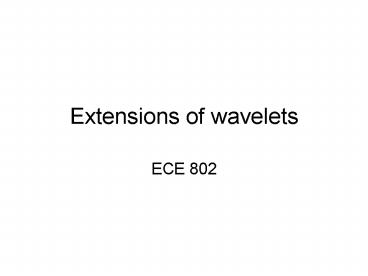Extensions of wavelets PowerPoint PPT Presentation
Title: Extensions of wavelets
1
Extensions of wavelets
- ECE 802
2
M-Band Wavelet Systems
- Generalization of dyadic wavelets
- Scale factor of M
- More flexible tiling of the time-frequency plane
3
Properties
- Scaling Equation
- Existence and Orthogonality
- M-1 wavelets
4
MRA
- At each scale j, there are M-1 wavelet functions
and one scaling function - If the wavelets are orthogonal to the scaling
function at the same scale
5
Analysis and Synthesis
- The expansion is
- The filter bank structure will now have M
branches - Gives a mixture of a logarithmic and linear
frequency resolution. - Easier to design for M2k
6
Wavelet Packets
- M2 results in a logarithmic frequency
resolution. The low frequencies have narrow
bandwidths and the high frequencies have wide
bandwidths. - Wavelet packet system proposed by Coifman
- Adjustable resolution of frequencies at high
frequencies - Computational complexity O(NlogN)
7
Wavelet Packet Decomposition
- In order to have higher resolution decomposition
at high frequencies, iterate the highpass wavelet
branch - Split both the lowpass and highpass bands at all
stages - Evenly spaced frequency resolution
- In DWT we consider the outputs of each channel.
- In WPD, we have more outputs than inputs?
redundant system - Choose an independent set as basis (not one
unique basis)
8
Optimization Criteria
- Search based on minimizing a cost function on the
transform coefficients. - Binary search algorithm for additive cost
function - How do we choose the best basis?
- Shannon entropy
- Thresholding the coefficients
- Log Energy
- Norm of the coefficients
- Two approaches
- Choose a particular decomposition based on the
signal class - Adapt the decomposition to each signal
9
Complexity
- P(J) The number of J-scale orthonormal wavelet
packet transforms - P(1)1
- P(J)P(J-1)21
- Application FBI standard for fingerprint image
compression
10
Haar Wavelet Packets
11
Wavelet Packet Tree
12
Optimization Functions
- Shannon Entropy
- Norm
- Log-Energy
- Threshold Entropy Number of times the
coefficient is larger than a threshold
13
Example Minimum Entropy Decomposition
- Start with a constant original signal. w00
ones(1,16)0.25 - Compute entropy of original signal.
- e00 wentropy(w00,'shannon') e00 2.7726
- Then split w00 using the haar wavelet.
- w10,w11 dwt(w00,'db1')
- Compute entropy of approximation at level 1.
- e10 wentropy(w10,'shannon') e10 2.0794
- The detail of level 1, w11, is zero the entropy
e11 is zero. Due to the additivity property the
entropy of decomposition is given by
e10e112.0794. This has to be compared to the
initial entropy e002.7726. We have e10 e11 lt
e00, so the splitting is interesting. - Now split w10 (not w11 because the splitting of a
null vector is without interest since the entropy
is zero). - w20,w21 dwt(w10,'db1')
- We have w200.5ones(1,4) and w21 is zero. The
entropy of the approximation level 2 is - e20 wentropy(w20,'shannon') e20 1.3863
- Again we have e20 0 lt e10, so splitting makes
the entropy decrease. - Then
- w30,w31 dwt(w20,'db1') e30
wentropy(w30,'shannon') e30 0.6931
w40,w41 dwt(w30,'db1') w40 1.0000
w41 0 e40 wentropy(w40,'shannon') e40
0 - Perform wavelet packets decomposition of the
signal s. - t wpdec(s,4,'haar','shannon')
14
Best Tree
15
Overcomplete Representations, Frames, Redundant
Transforms
- There are many cases where a single basis is not
effective for signal representation. - Example Fourier basis is good for sinusoids, but
bad for transients - Efficiency of the transform can be improved by
combining several basis systems. - Combination of basis systems?Overcomplete
- Collection of basis systems is called a
dictionary.
16
Desired Criteria
- Sparsity Efficient representation
- Separation Better ability to separate a mixture
of signals - Superresolution Higher resolution or detail
compared to a single basis - Stability Robust under noise, the selected atoms
do not change - Speed
17
Definitions
- Frame Generalization of a basis, a collection of
functions that span the vector space, but are not
linearly independent - The frame condition
- 0ltAltBlt8
- If AB, tight frame
- If AB1, orthonormal basis
18
Frame Examples
- Tight Frame 4 basis functions in 3-dimensional
space
19
Matching Pursuit
- Matching pursuit (MP) algorithm finds a
sub-optimal solution to the problem of an
adaptive approximation of a signal in a redundant
set (dictionary) of functions. - Look for a linear expansion of a signal in terms
of elements (atoms) of a dictionary.
20
Algorithm Mallat, Zhang 1993
- At each step, try to find the element of the
dictionary that best fits the signal. - Energy Conservation
- For a complete dictionary as M?8, the residue
should go to zero. - Stopping Criteria Threshold the residue or
pre-determine M
21
Dictionary
- Commonly used dictionary Gabor functions,
dictionary of time-frequency atoms - General and compact model for oscillations
- Compact time-frequency localization
- Restrict the search to a range of time,
frequency, and scale values
22
Applications
- EEG Spike Parametrization
23
Extensions
- Multichannel MP Jointly represent a class of
signals using the same elements of the dictionary - Orthogonal Matching Pursuit (OMP)
- Efficient greedy algorithm
- Applies Gram-Schmidt orthogonalization to the
selected atoms before computing the residue - The selected atoms are orthogonalized with
respect to the residue - Faster convergence than MP
24
Basis PursuitChen, Donoho
- Convex optimization Find the representation that
minimizes the l1 norm of the coefficients - Solved using linear programming
- Nearly linear time
- l1 norm guarantees sparsity, l2 norm does not
(Method of Frames)
25
Examples
- FM-Cosine signal
26
Comparisons
- MP and OMP are iterative algorithms.
- MP starts from an empty signal model and builds
it up one atom at a time - BP starts from a full model and iteratively
improves the full model. - Wavelet Packet Decomposition (Best Orthogonal
Basis) focuses only on the orthogonal bases. - MOF l2 solution, not sparse, can be noisy.

